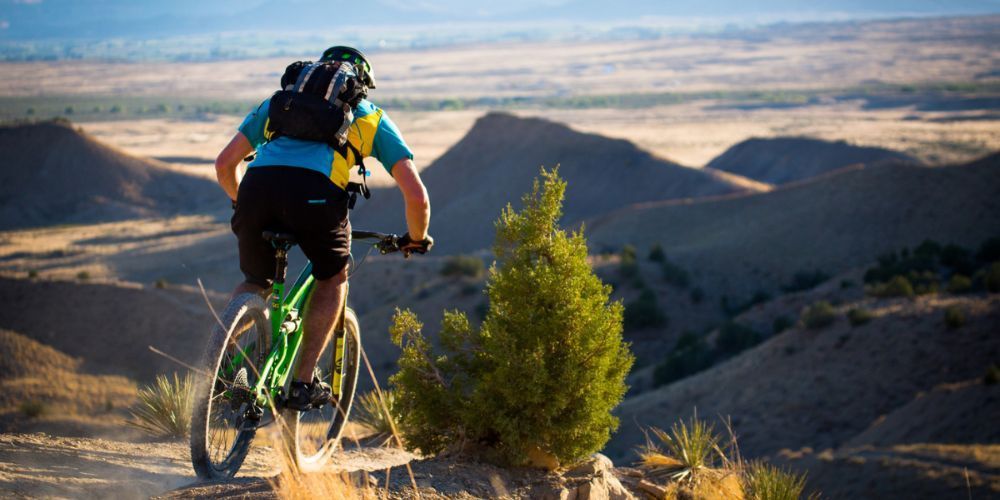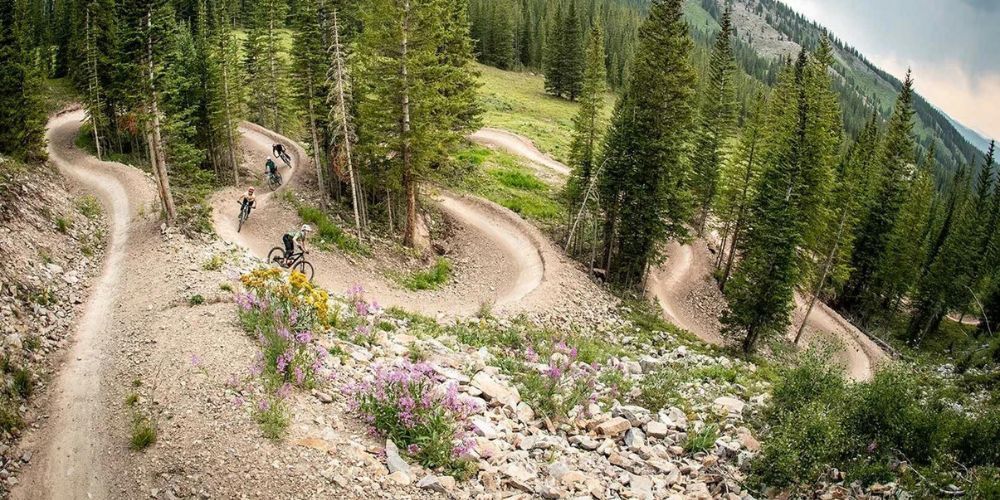The Ultimate Guide to Mountain Biking in Colorado: Best Trails, Tips, and Gear
June 19, 2024
Mountain biking in Colorado is an unforgettable experience waiting for you. With numerous jaw-dropping trails like the striking Monarch Crest Trail, each ride promises a unique blend of thrill and scenic beauty. The terrain varies widely, catering to both intermediate and advanced riders, making it a versatile biking destination. Surprises await at every corner, from the breathtaking landscapes to the diverse wildlife that calls these mountains home. Now, let's talk about one of the spectacular trails...
The top mountain biking trails in Colorado include the 401 Trail near Crested Butte, the Monarch Crest Trail in Salida, and the Whole Enchilada in Moab (just over the border in Utah). These trails offer breathtaking scenery and varying levels of difficulty for both beginner and experienced riders. Remember to always check current trail conditions and be prepared with appropriate gear for a safe and enjoyable ride.

Our Top Colorado Mountain Bike Trails
If you're seeking a memorable mountain biking experience, Colorado is the place to be. With its rugged terrain, gorgeous landscapes, and thrilling trails, it's a paradise for biking enthusiasts. Let's explore some of the most iconic trails that the state has to offer.
Monarch Crest Trail
Immerse yourself in breathtaking views of the Continental Divide and lush forests as you ride through this iconic trail. The Monarch Crest Trail is known for its challenging yet incredibly rewarding experience. With an elevation above 11,000 feet, riders traverse through high-alpine terrain, encountering steep descents and exhilarating singletrack sections. This trail caters to intermediate to advanced riders looking for an adrenaline-pumping adventure.
401 Trail
As the snow melts, the 401 Trail transforms into a colorful tapestry of wildflowers, offering riders a visual feast as they navigate through its adventurous route. Nestled in the Elk Mountains, this trail boasts majestic views that are truly awe-inspiring. The exhilarating ride allows riders to meander through aspen groves and across alpine meadows, making it an absolute must-ride for mountain biking enthusiasts seeking both natural beauty and an exciting challenge.
Quick Tip: For the best experience on these trails, ensure your bike is properly maintained and equipped with reliable tires suitable for various terrains.
The Colorado Trail
Stretching nearly 500 miles from Denver to Durango, the Colorado Trail is a testament to the state's diverse landscapes and varied terrain. Divided into segments, each offering its own unique challenges, this trail provides riders with an unforgettable journey. From dense forests to alpine tundra and everything in between, riders can expect an ever-changing backdrop throughout their adventure. It's not just a trail—it's an expedition through some of Colorado's most mesmerizing landscapes.
Each of these trails offers a distinct character and promises an invigorating experience for mountain biking enthusiasts. Whether you're seeking heart-pounding descents or scenic alpine rides, Colorado's diverse trails have something to offer for every rider.As you gear up for your mountain biking expedition in Colorado, understanding the essential gear and supplies you'll need is crucial. Let's delve into the must-haves to ensure a safe and enjoyable adventure on these stunning trails.
Gear and Supplies You'll Need
When hitting the mountain biking trails in Colorado, having the right gear is not just a matter of comfort—it’s a matter of safety. Let’s break down the essential items you should have with you when you head out for a ride.
Helmet
A well-fitting, properly vented helmet is absolutely crucial. Not only is it a legal requirement in many places, but it's a key piece of protective equipment that could save your life. Look for a helmet that is certified by organizations like the Consumer Product Safety Commission (CPSC) or Snell.
Remember, even on easier and more familiar trails, accidents can happen, so never skip wearing your helmet. It offers the important protection you need if the unexpected occurs.
Trail Map/GPS
Navigational aids are crucial for mountain biking. Whether it's a physical trail map or a GPS device, having a way to navigate the complex web of trails in Colorado ensures that you can plan your route effectively and stay on course during your rides.
Exploring unfamiliar terrain can be thrilling, but getting lost is not part of the adventure. By having a reliable navigational aid, you can focus on enjoying the ride instead of worrying about finding your way back.
Hydration Pack
Staying hydrated during mountain biking is especially important in higher altitudes. Dehydration can hit you hard in the thin air, so carrying a hydration pack with ample water is necessary for longer rides.
On top of hydration, these packs often have compartments for carrying energy bars, tools, and other essentials, minimizing the need for additional storage on your bike.
Bike Repair Kit
In addition to staying safe and hydrated, being prepared for potential mechanical issues on the trail is equally important. A bike repair kit should include a spare tube, tire levers, multi-tool, and a mini-pump for any trailside maintenance needs.
Being able to quickly fix flat tires or make minor adjustments will keep your ride uninterrupted and prevent unnecessary frustration while out on the trails.
Always be prepared with these essentials before setting off on your mountain biking adventures in beautiful Colorado!
Nailing down the basics before hitting the trails sets the stage for an exhilarating experience. Now let's delve into understanding the different trail difficulty levels and how to navigate through them with confidence.
Understanding Trail Difficulty Levels
When hitting the mountain biking trails in Colorado, one of the most important things to consider is the trail difficulty level. These skill ratings - from green/easy, blue/intermediate, to black/difficult - give you an understanding of what you're getting into.
Green/Easy
Green or easy trails are perfect for beginners and families. They're relatively flat and smooth, offering a gentle introduction to mountain biking. The emphasis here is on enjoying the ride rather than tackling technical challenges. These trails are great for experiencing wilderness while building confidence and basic skills.
For those who enjoy easier rides but want to step up the challenge a bit, there are also "green circle" trails within this category. These can offer a slight increase in difficulty over traditional green trails without being too overwhelming.
Blue/Intermediate
As you gain more experience and feel comfortable with biking basics, blue/intermediate trails become enticing options. These trails incorporate some technical features such as rocks and roots but are still manageable for riders with some experience. They provide a taste of more challenging terrain without overwhelming intermediate riders. These trails strike a balance between enjoyment and technicality, offering a chance for riders to hone their skills while providing an exciting challenge.
Black/Difficult
Black difficulty trails are designed for experienced riders seeking a thrill. These trails feature steep descents, technical obstacles, and challenging terrain that demand advanced riding skills. They require strong bike-handling abilities, quick decision-making, and the confidence to navigate through tough sections.
Understanding these difficulty levels helps you select trails that match your skill level and comfort zone, ensuring a safe and gratifying mountain biking adventure in Colorado's breathtaking landscapes. Whether you're seeking an easy cruise or an adrenaline-pumping challenge, there's a trail perfectly suited for you in the diverse mountain biking paradise of Colorado.
As we've gained insights into the varying trail difficulty levels across Colorado's mountain biking terrain, it's now time to turn our attention to another crucial aspect – the best time of year to experience these exhilarating rides.

Best Time Of Year To Bike In Colorado
Colorado is a mountain biker's paradise, with its diverse landscapes and varying elevations offering unique experiences throughout the seasons. The best time to explore the trails typically falls between late spring and early fall when the weather is mild and most of the trails are open for riding. During this time, you'll find yourself surrounded by beautiful wildflowers, lush greenery, and comfortably warm temperatures that make for an exceptional biking experience.
Late spring to early fall offers the most favorable mountain biking conditions in Colorado. June and July usually offer the lushest and most vibrant scenery, making it a popular choice for mountain bikers seeking breathtaking views along the trails.
At lower elevations such as in the foothills near Denver or Boulder, you may find mountain biking accessible during the winter months as well, depending on the weather. However, it's essential to note that higher elevation trails can remain snow-covered late into spring or even early summer.
Moreover, autumn in Colorado brings its own charm to mountain biking. The changing colors of the aspen trees against the backdrop of majestic mountains create a remarkable setting for a ride.
It's important to keep in mind that weather conditions can vary greatly in the mountains, and sudden changes are not uncommon. As a result, being prepared for unexpected changes in weather is crucial for any mountain biking excursion.
Always check the weather forecast before heading out on your ride, and make sure you have appropriate gear for various conditions.
While spring and summer showcase vibrant colors and flourishing vegetation, they also mark the peak season for thunderstorms in Colorado. These storms can be intense and swift, posing potential risks for bikers. It's advisable to plan your rides in the mornings to avoid afternoon thunderstorms particularly during these seasons.
With these considerations in mind about timing your biking trips, let's now explore some of the top trails across Colorado that offer incredible mountain biking experiences.
Most Popular Biking Areas in Colorado
Colorado homes some of the most thrilling and picturesque mountain biking trails in the United States. With its diverse landscapes spanning from deserts to mountains, there's something for every type of rider. Here are a few of the most sought-after mountain biking areas that draw adrenaline-seeking enthusiasts from all over:
Fruita
Located in western Colorado, Fruita is a mecca for mountain bikers seeking epic singletrack trails amid stunning desert scenery. From challenging technical routes to more mellow rides, Fruita offers a bit of everything for both beginners and seasoned riders.
If you fancy riding through surreal desert landscapes with red rock formations towering around you, Fruita is the place to be.
The colorful landscape provides not only an exciting terrain but also a visually stunning backdrop for your ride. The trails wind through canyons, twist around rock formations, and offer panoramic views that will take your breath away. The moderate winter climate allows riding nearly year-round, making Fruita an attractive destination regardless of the season.
Crested Butte
Crested Butte is synonymous with world-class mountain biking, offering an extensive network of trails that cater to a variety of skill levels. Whether you're seeking smooth flowy rides through wildflower-strewn meadows or technical descents that get your heart racing, Crested Butte has it all.
If you're looking for a mix of soul-feeding wildflower meadows and challenging rugged terrain all against a stunning mountain backdrop, then Crested Butte is where you want to be.
Crested Butte's diverse range of trails makes it an ideal destination for both casual riders and hardcore enthusiasts alike. The town's welcoming vibe and laid-back atmosphere add to the overall charm, making it a must-visit location for any mountain biking enthusiast.
Durango
Nestled in the heart of the San Juan Mountains, Durango boasts an extensive trail system that showcases the breathtaking beauty of Colorado. The region offers trails suited for all skill levels, from beginner-friendly paths to heart-pounding downhill tracks that challenge even the most experienced riders.
Durango combines varied scenery with diverse trail options—whether you want a leisurely ride through aspen groves or an adrenaline-pumping downhill descent, this area has got you covered.
With its blend of scenic beauty and dynamic trails, Durango truly embodies the spirit of mountain biking in Colorado. The town's vibrant mountain biking culture adds an extra layer of excitement to the whole experience.
These iconic areas underline why Colorado is heralded as a top-notch mountain biking destination, capturing the essence of adventure and natural beauty that beckons all outdoor enthusiasts.
As we immerse ourselves in the realm of Colorado's exhilarating biking trails, let's now set our sights on navigating through its rugged terrain.
Navigating through Colorado's Terrain
Navigating Colorado's varied terrain is a thrilling but challenging experience for mountain bikers. One minute you may be powering up a steep incline, and the next, tackling a rocky, technical descent. Here are some essential techniques and considerations to keep in mind for successfully maneuvering through Colorado's magnificent landscapes.
Uphill Techniques
Climbing steep sections on a mountain bike requires a unique set of techniques to maintain momentum and manage the rugged terrain. When approaching an uphill climb, it's crucial to shift into an appropriate gear that allows for steady pedaling without excessive strain. Leaning forward slightly while keeping a firm grip on the handlebars helps distribute your weight more evenly, providing better traction to navigate loose or uneven surfaces. Pacing yourself is essential; it's often more effective to maintain a consistent cadence rather than pushing too hard and burning out quickly. Embracing a "slow and steady" approach ensures that you conserve energy for longer rides and challenging sections later in the trail.
Downhill Techniques
As exhilarating as downhill segments can be, they also demand a high level of skill and caution. Effective braking and maintaining control during fast descents are paramount for a safe and enjoyable ride. Keeping your weight centered over the bike while slightly leaning back helps stabilize your position and manage obstacles with greater ease. Expertly modulating the brakes allows you to manage speed without skidding or losing control, particularly on rocky or slippery surfaces. Anticipating obstacles and adjusting your line accordingly is a skill that comes with practice; however, it significantly enhances your ability to navigate technical downhill sections confidently.
Altitude Considerations
Colorado's elevation presents a unique challenge for mountain bikers due to its high-altitude trails. It's crucial to be mindful of the effects of altitude on physical exertion, as diminished oxygen levels can lead to fatigue and reduced performance. Gradual acclimatization is key when riding at higher elevations, allowing your body to adjust to the thinner air and lower oxygen saturation levels. Staying well-hydrated and taking regular breaks can help mitigate the impact of altitude-related challenges, ensuring that you can fully savor the captivating scenery and exhilarating trails that Colorado has to offer.
Mastering these uphill and downhill techniques, along with being mindful of altitude considerations, equips mountain bikers with the skills and awareness necessary to conquer Colorado's diverse and awe-inspiring terrain with confidence and enjoyment.
As you prepare to conquer the thrilling mountain biking trails in Colorado, let's explore some essential tips to enhance your riding experience in this exhilarating landscape.
Essential Mountain Biking Tips in Colorado
Mountain biking in Colorado is exhilarating, adventurous, and at times quite challenging. To make the most out of your adventure, here are some indispensable tips to consider as you hit the trails.
Stay Informed
Before embarking on a thrilling mountain biking expedition in Colorado, it's imperative to stay informed about trail conditions and local regulations. This means checking for any recent updates on trail closures, maintenance work, or weather-related advisories. Many areas have seasonal closures to protect wildlife and reduce erosion. By staying informed, you not only ensure your own safety but also uphold responsible stewardship of the trail system.
For example, certain trails have specific rules such as giving way to hikers or horseback riders, while others may have designated one-way routes. By familiarizing yourself with these regulations beforehand, you contribute to a harmonious sharing of the trails among different user groups, making the experience more enjoyable for everyone involved.
Respect Wildlife
Colorado's natural landscape is teeming with diverse wildlife, offering thrilling opportunities to observe creatures like deer, elk, and even the occasional bear. When encountering wildlife while biking, it's essential to yield to animals and respect their habitat.
Imagine rounding a bend in the trail to be met by a majestic moose grazing peacefully. In this scenario, maintaining a respectful distance and allowing the animal to move freely ensures your safety as well as the tranquility of the wildlife and its natural environment.
Leave No Trace
Preserving Colorado's natural beauty is a collective responsibility that every mountain biker should embrace. One of the most fundamental principles is "Leave No Trace," which involves packing out all trash and adhering to trail etiquette.
Picture this—a serene mountain trail with breathtaking vistas at every turn. By meticulously adhering to "Leave No Trace" principles and being mindful of your impact on the environment, you actively contribute to the preservation of Colorado's stunning landscapes for future generations to enjoy.
By incorporating these essential mountain biking tips into your adventure, you not only enhance your own experience but also contribute to preserving the natural beauty of Colorado's trails for years to come. It's through these small yet significant actions that we continue to foster a culture of responsible outdoor recreation in this breathtaking state.
What are the best mountain biking trails in Colorado?
Colorado is a mountain biking paradise, boasting a variety of trails that cater to different skill levels and preferences. Some of the top trails include:
- Monarch Crest Trail: Known for its stunning views and diverse terrain, this trail is a must-ride for experienced bikers. It offers a mix of singletrack, technical sections, and fast descents.
- The Whole Enchilada: While primarily in Utah, this epic ride often includes the Kokopelli Trail, which starts in Colorado. It's a bucket-list ride for many bikers due to its length and challenging terrain.
- 401 Trail in Crested Butte: Famous for its wildflower-filled meadows and breathtaking mountain views, this trail is ideal for intermediate riders looking for a scenic adventure.
- Buffalo Creek Trail System: Located near Denver, this trail system offers a variety of loops and is known for its smooth singletrack and stunning rock formations.
- Lunch Loops in Grand Junction: These trails are known for their technical challenges and rugged beauty, making them a favorite among advanced riders.
What is the best time of year to go mountain biking in Colorado?
The ideal time for mountain biking in Colorado is from late spring to early fall, typically May through October. During these months, the weather is generally mild, and the trails are clear of snow.
- Spring (May to June): Early spring can still be snowy at higher elevations, but lower elevation trails start to open up. The weather can be unpredictable, so be prepared for variable conditions.
- Summer (July to August): This is peak biking season with warm, stable weather. Higher elevation trails are fully accessible, offering cooler temperatures and lush landscapes.
- Fall (September to October): Fall is a favorite time for many bikers due to the beautiful foliage and cooler temperatures. Trails are less crowded, providing a more serene riding experience.
What gear is essential for mountain biking in Colorado?
Having the right gear is crucial for a safe and enjoyable mountain biking experience in Colorado. Essential gear includes:
- Quality Mountain Bike: A sturdy, well-maintained bike suited to the trails you'll be riding. Full suspension bikes are popular for their comfort and control.
- Helmet: A properly fitting helmet is a must for safety.
- Gloves: Biking gloves improve grip and protect your hands.
- Hydration Pack: Staying hydrated is vital, especially at higher altitudes. A hydration pack allows you to carry water and other essentials.
- Proper Clothing: Wear moisture-wicking, breathable clothing. Layers are important as weather can change rapidly.
- Repair Kit: A basic repair kit with a multi-tool, spare tube, tire levers, and a pump or CO2 inflator can help you address common mechanical issues.
- Protective Eyewear: Sunglasses or goggles protect your eyes from debris and bright sunlight.
Are there mountain biking trails suitable for beginners in Colorado?
Colorado has numerous trails that are perfect for beginners, offering gentle terrain and less technical challenges. Some beginner-friendly trails include:
- Valmont Bike Park in Boulder: This park features a variety of trails and skills areas designed for all levels. It's a great place for beginners to practice and build confidence.
- Bear Creek Lake Park in Morrison: With its smooth, well-maintained trails and beautiful scenery, this park is ideal for new riders.
- Marshall Mesa in Boulder: These trails offer easy climbs and smooth descents, perfect for beginners getting a feel for mountain biking.
- Buffalo Creek Trails: While the system has advanced trails, it also offers beginner-friendly loops with minimal technical features.
- Cherry Creek State Park in Aurora: A great spot for novices, with flat and wide trails that provide a gentle introduction to mountain biking.
What safety tips should I follow while mountain biking in Colorado?
Safety is paramount when mountain biking. Here are some important tips to keep in mind:
- Always Wear a Helmet: Protect your head in case of falls or collisions.
- Stay Hydrated: Drink plenty of water, especially at higher altitudes where dehydration can occur more quickly.
- Ride Within Your Skill Level: Choose trails that match your ability and gradually progress to more challenging ones.
- Check Weather Conditions: Colorado's weather can change rapidly. Be prepared for sudden storms or temperature drops, and avoid riding in dangerous conditions.
- Inform Someone of Your Plans: Let someone know your riding plan and expected return time, especially if you're biking in remote areas.
- Carry a First Aid Kit: A small first aid kit can be invaluable in case of minor injuries.
- Know the Trail Rules: Respect trail regulations and yield to other trail users, such as hikers and horseback riders.
- Bring a Map or GPS Device: Navigation tools can help you stay on course and avoid getting lost, particularly on unfamiliar trails.
Check out the latest reviews on mountain biking gear
Author: William Flaiz










